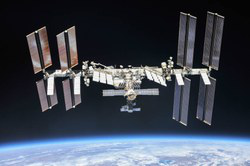January 7, 2020 -- An astronaut on the International Space Station using an onboard ultrasound scanner to research the effects of space flight instead detected their own venous thrombosis, according to an article published in the January 2 issue of the New England Journal of Medicine.
Two months into a six-months-long mission on the International Space Station, the astronaut identified a potential blood clot while performing a self-directed ultrasound exam as part of a vascular research study. A follow-up ultrasound exam performed by the astronaut with guidance from two radiologists on Earth confirmed that the blood clot was a deep vein thrombosis (DVT) in the jugular vein of the neck (
NEJM, January 2, 2020, Vol. 382:1, pp. 89-90).
Treatment of the condition typically entails taking blood-thinning medication for several months to prevent the clot from growing and moving to a different part of the body, noted co-author Dr. Stephen Moll in a statement released by the University of North Carolina School of Medicine. Moll is a professor of medicine at the university and a member of its Blood Research Center.
"There is some risk when taking blood thinners that if an injury occurs, it could cause internal bleeding that is difficult to stop. ... Knowing there are no emergency rooms in space, we had to weigh our options very carefully," he said.
Moll discussed treatment options with a team of NASA physicians and finally advised the astronaut to take a blood thinner for approximately 90 days, with regular ultrasound exams guided by radiologists to monitor the blood clot. The medical team also advised the astronaut to stop taking the blood thinner four days before the journey back home to Earth due to the high physical demands involved in the reentry process.

The International Space Station. Image courtesy of NASA.
After landing on Earth, the astronaut underwent a point-of-care ultrasound exam that indicated the astronaut no longer required further treatment for DVT. The astronaut remained asymptomatic on a follow-up exam six months after returning to Earth, the authors found.
The case of DVT in spaceflight underscores the complexities of space medicine, which, for this astronaut, included patient-performed, radiologist-guided ultrasonography, Moll and colleagues noted. The case revealed gaps in current understanding of circulatory and hemostatic physiology in space, as well as the need for more research on how blood and blood clots behave in space.
"How do you minimize risk for DVT?" Moll said. "Should there be more medications for it kept on the International Space Station? All of these questions need answering, especially with the plan that astronauts will embark on longer missions to the moon and Mars."





